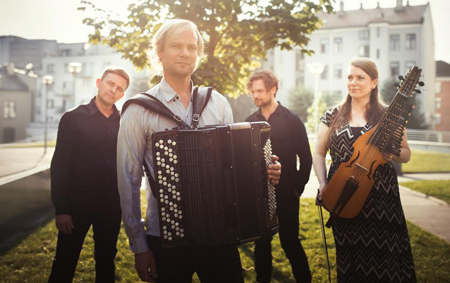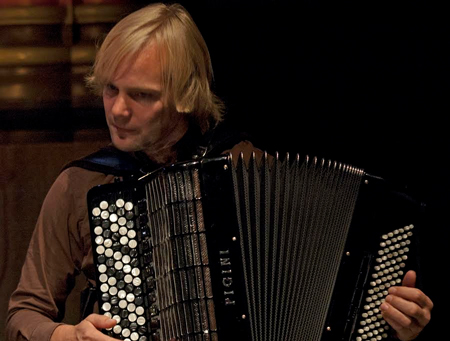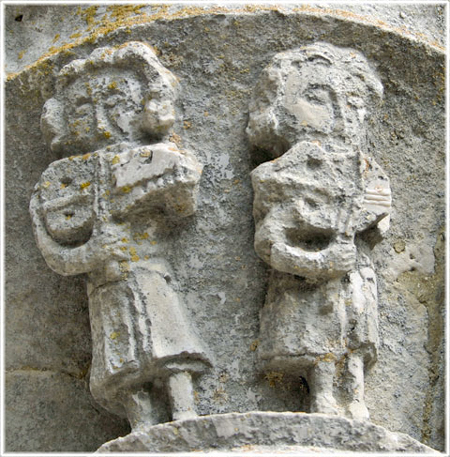By Mike Telin

On Wednesday, March 29 at 7:30 pm in Gartner Auditorium, the Cleveland Museum of Art will present Frode Haltli’s The Border Woods (Grenseskogen). The performance will feature Frode Haltli (accordion), Emilia Amper (nyckelharpa), and Eirik Raude (percussion).
“I love the sound of the nyckelharpa,” Haltli said, “and Emilia is one of the great folk musicians in Scandinavia. I adore her playing and her approach to traditional music, so I wanted to write something that she could play as freely as she plays folk music. I didn’t want to score every detail, I wanted her to add her own touch to it.”
Emilia Amper holds Haltli in equally high regard. “Frode is so amazing. The first time that we played together we clicked right away,” Amper said via Skype from her home in Sweden. “He’s creatively used so many musical inspirations in the piece, because he is such a virtuoso player of contemporary classical music, experimental, and folk music.”
The first time Haltli combined contemporary classical and improvised folk music was in his 2007 recording, Tossing Images, but he said that The Border Woods takes what he did on that recording even further. “The sound world of the piece is more from contemporary music, especially with the two percussionists who play cymbals, musical glasses, marimba, and vibraphone. It does not sound traditional, but you clearly hear the connection to Scandinavian music.” (View a short video excerpt from The Border Woods here.)
The work also traces the connections between Nordic folk music and Arabic scales. How did Haltli discover those connections? “I have a friend and fellow musician, Trygve Seim, who has a background in jazz. At one point, he was into Arabic classical music, and he asked me if I could take one of my smaller accordions to Egypt to have it tuned in an Arabic scale. So I did.”

He later discovered that Amper’s nyckelharpa could play quarter-tones, the kind that are common in Scandinavian folk music. Haltli also realized that his re-tuned accordion and her instrument could play the same scales. “At the end of The Border Woods we play together and create something new out of something old. I’m not trying to write Arabic music, that’s not the idea of the piece. It’s more to use these elements and create some atmospheres that hopefully are interesting and beautiful. Some of it may sound a bit familiar, but you won’t exactly know where you heard it before.”
Emilia Amper has performed with Nordic folk music groups, and Persian classical, jazz, and rock musicians, as well as with the Norwegian Chamber Orchestra. She earned a Bachelor in Musicology from the University in Trondheim, a Bachelor in Swedish Folk Music from the Royal University College of Music in Stockholm, and a Masters in Nordic Folk Music.
The roots of the nyckelharpa go back to Medieval times, however it is difficult to know exactly where the first instruments were made. “The idea of putting keys on a bowed instrument popped up in different places in Northern Europe around the same time,” Emilia Amper said, noting that there is evidence that the instrument existed in Finland, Norway, and Denmark, as well as in Northern Germany and Poland. “But it disappeared everywhere except in Uppland, Sweden, a tiny region just north of Stockholm, and it’s a mystery as to why it survived there.”

Although the early instruments were much smaller than they are today, and were only equipped with three strings and twelve keys, over time the body became larger as more strings were added. During the seventeenth century the instrument acquired sympathetic strings.
“By the middle of the twentieth century the tradition of playing nyckelharpa was almost lost,” Amper said. “Because it was a drone instrument that could only play in certain musical keys, it was incapable of playing modern music. But there was a frustrated nyckelharpa player, August Bohlin, who wanted to play new music, so he created the chromatic nyckelharpa.”
The instrument was further developed by Eric Sahlström, a composer, player, and maker of nyckelharpas, but still the instrument’s popularity continued to decline until the Roots Revival of the ‘60s and ‘70s. “That was kind of a hippie time in Sweden — people were interested in handicraft and old traditions, one of which was building nyckelharpas. It became popular for people to attend workshops on how to make the instruments based on Sahlström’s drawings. Even today people still tell me that their grandmothers went to a workshop in the ‘70s and built a nyckelharpa that they still have in their wardrobe.”

Today the instrument is used to perform all styles of music from folk to Bach to rock. Amper has even performed Persian classical music and Flamenco on the nyckelharpa. Part of what makes it such a versatile instrument is that can be tuned in different temperaments. “Since I play so many styles of music with piano, guitar, and accordion, equal temperament is the best way for me to go.” To read an article by Emilia Amper about tuning the instrument, click here.
Although Amper did not come from a folk music family, she always loved music. How did she find her way to the nyckelharpa? “When I was ten, the music school teachers came around and showed us all the different instruments we could choose from. It just so happened that the fiddle teacher also taught nyckelharpa. She played it and I was taken with it right away,” Amper recalled. “I went home and told my parents that I was going to play the nyckelharpa, and they said, Great — what is that?”
Amper, who quickly took to the instrument, said that she was lucky because her grandfather bought her a nyckelharpa which was far better than the borrowed school instrument. “I was so in love with it, I didn’t let anybody carry it — I even slept with it beside me in my bed.”
Emilia Amper said that she could not be happier that the instrument has survived. “Now it’s like we’re taking over the world. If you meet someone who plays it, you are immediate friends. We call ourselves the international nyckelharpa mafia.”
Published on ClevelandClassical.com March 24, 2017.
Click here for a printable copy of this article


